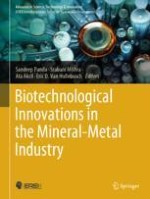The book presents the most advanced biotechnological information with respect to microbial applications in the treatment of mineral-metal bearing wastes. With growing interest in practical industrial applications of biomining microbes, of late, a lot of research has been devoted towards exploring their biotechnological potential for processing wastes derived from both primary and secondary resources for metal recovery. The chapters in the book present compiled information on several aspects of this exciting area of mineral biotechnology, that include fundamental, applied, bioprocess engineering and environment in separate chapters. These chapters provide updated information on the microbe-mineral interactions; resource specific bioleaching covering base, precious and rare earth elements leaching from primary and/or secondary resources; processing of leach solutions through biosorption, biomineralization, bio-electrochemical systems for resource recovery; treatment of mine waters, engineering and scale-up aspects of bioreactor systems for bioleaching of specific wastes and environmental challenges related to bio-mining. The book provides a unique platform for the dissemination of the state-of-the-art research on mineral biotechnology and serves as a bridge between academia and industry. Authored by well-renowned experts, it is an appropriate reference for graduate students, scientists, engineers, environmentalists working in the area of mineral biotechnology and industrial technologies.
